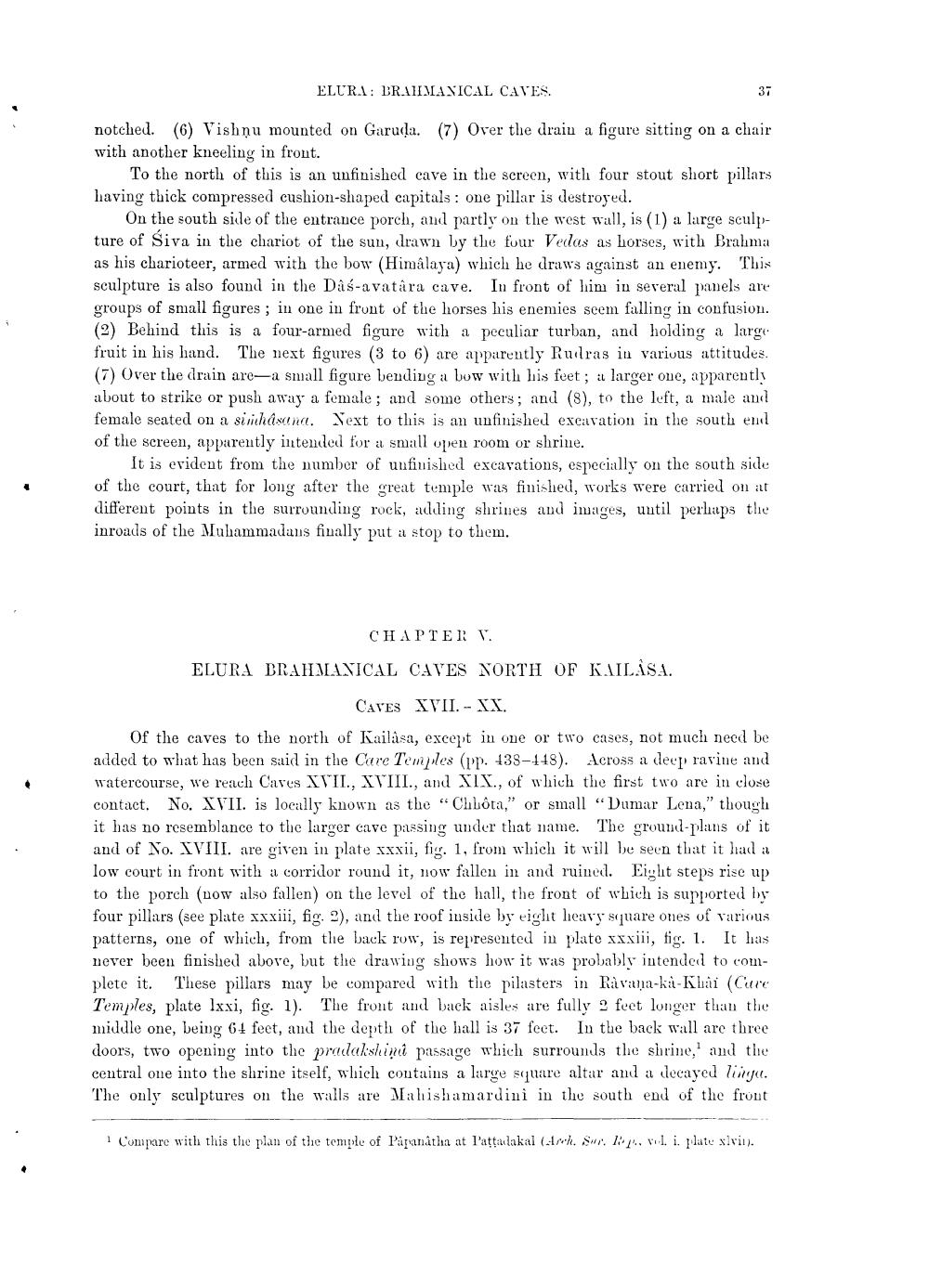________________
ELURA: BRAHMANICAL CAVES.
37
notched. (6) Vishnu mounted on Garuda. (7) Over the drain a figure sitting on a chair with another kneeling in frout.
To the north of this is an unfinished cave in the screen, with four stout short pillars having thick compressed cushion-shaped capitals: one pillar is destroyed.
On the south side of the entrance porch, and partly on the west wall, is (1) a large sculp ture of Śiva in the chariot of the sun, drawn by the four Vedas as horses, with Brahma as his charioteer, armed with the bow (Himalaya) which he draws against an enemy. This sculpture is also found in the Dâś-avatara cave. In front of him in several panels are groups of small figures; in one in front of the horses his enemies seem falling in confusion. (2) Behind this is a four-armed figure with a peculiar turban, and holding a large fruit in his hand. The next figures (3 to 6) are apparently Rudras in various attitudes. (7) Over the drain are a small figure bending a bow with his feet; a larger one, apparently about to strike or push away a female; and some others; and (8), to the left, a male and female seated on a simhasana. Next to this is an unfinished excavation in the south end of the screen, apparently intended for a small open room or shrine.
It is evident from the number of unfinished excavations, especially on the south side of the court, that for long after the great temple was finished, works were carried on at different points in the surrounding rock, adding shrines and images, until perhaps the inroads of the Muhammadans finally put a stop to them.
CHAPTER V.
ELURA BRAHMANICAL CAVES NORTH OF KAILASA.
CAVES XVII. - XX.
Of the caves to the north of Kailasa, except in one or two cases, not much need be added to what has been said in the Care Temples (pp. 438-448). Across a deep ravine and watercourse, we reach Caves XVII., XVIII., and XIX., of which the first two are in close contact. No. XVII. is locally known as the "Chhota," or small "Dumar Lena," though it has no resemblance to the larger cave passing under that name. The ground-plans of it and of No. XVIII. are given in plate xxxii, fig. 1, from which it will be seen that it had a low court in front with a corridor round it, now fallen in and ruined. Eight steps rise up to the porch (now also fallen) on the level of the hall, the front of which is supported by four pillars (see plate xxxiii, fig. 2), and the roof inside by eight heavy square ones of various patterns, one of which, from the back row, is represented in plate xxxiii, fig. 1. It has never been finished above, but the drawing shows how it was probably intended to complete it. These pillars may be compared with the pilasters in Ravaun-ki-Khi (Care Temples, plate lxxi, fig. 1). The front and back aisles are fully 2 feet longer than the middle one, being 64 feet, and the depth of the hall is 37 feet. In the back wall are three doors, two opening into the pradakshid passage which surrounds the shrine, and the central one into the shrine itself, which contains a large square altar and a decayed linga. The only sculptures on the walls are Mahishamardini in the south end of the front
1 Compare with this the plan of the temple of Papanatha at l'aṭṭadakal (Arch. Sur. Bp., vol. i. plate xlvin.




